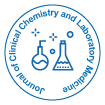
Journal of Clinical Chemistry and Laboratory Medicine
Open Access
ISSN: 2736-6588

ISSN: 2736-6588
Perspective - (2022)Volume 5, Issue 10
Interleukins are a group of related proteins made by white blood cells and other cells in the body. Interleukins regulate immune responses in human body. Interleukin-6 (IL-6) is a protein produced by various cells. It may help modulate the immune response, making IL-6 testing useful as a marker of immune system activation. Laboratory-generated interleukins have been used as biological response modifiers to boost the immune system in cancer therapy. Therefore, the main function of interleukins is to regulate growth, differentiation and activation during inflammation and immune responses. Interleukins comprise a large group of proteins that can influence many responses in cells and tissues by binding to high-affinity receptors on the cell surface. Pro-inflammatory interleukins induce a Th1, pro-inflammatory phenotype in lymphocytes, while anti-inflammatory interleukins induce a shift to a Th2 profile, with attenuation of pro-inflammatory cytokine expression and concomitant increase in anti-inflammatory cytokine expression. Overexpression of this cytokine is involved in the pathology of many diseases such as diabetes, rheumatoid arthritis and cancer. Along with IL-1 and Tumor Necrosis Factor-alpha, (TNF-α), IL-6 also plays as one of the most important cytokines during infection. Interleukin (IL)-6 is produced at sites of inflammation and plays a key role in the acute phase response defined by a variety of clinical and biological features, including production of acute phase proteins. Interleukin-1, an inflammatory cytokine, has diverse physiological functions and pathological significance and plays an important role in health and disease. IL-1 is also an important cytokine for cell, tissue and organ homeostasis from a general pathological point of view as well as inflammation associated with cell injury. Recent studies have been going on how to expand IL-1 signaling to treat diseases. In addition to being an immune protein, IL-6 is also a pyrogen and also a reason of fever in autoimmune, infectious or non-infectious diseases. IL-6 is produced by the body where acute or chronic inflammation occurs. This includes situations such as trauma, burns, cancer, and infections. This chemical interacts with interleukin-6 receptor alpha to induce transcription of proinflammatory gene products. IL-6 is released from monocytes and macrophages in response to IL-11 and other inflammatory cytokines such as tumor necrosis factor (TNF) beta. IL-6 receptors are present on normal resting T lymphocytes, normally activated by B cells, and cells of myeloid and hepatocytic lineages. IL-6 is also found on B cells modified by the Epstein- Barr virus. It produces inflammatory effects by inducing the transcription of factors in multiple inflammatory pathways. These are due to the release of protein kinase C, cAMP/protein kinase A, and calcium. IL-6 is a molecule with multiple forms and functions depending on where it is secreted. IL-6 also helps T cells to differentiate in the early stages of development. This chemical is required for progenitor cell development and activation of T cells and Natural Killer (NK) cells. In addition, IL-6 helps these cells to lyse pathogens intracellularly. IL-6 also helps promote B cell differentiation, proliferation, and the formation of plasma cells from B cells. Additionally, as a growth factor for these cells, IL-6 promotes the release of antibodies in the form of immunoglobulin A (IgA) and IgG. IL-6 is also important in the development of blood cells such as white blood cells, red blood cells and platelets. Reported IL-6 levels in the blood of healthy donors range from 0 to 43.5 pg/mL. The pooled IL-6 estimate was 5.186 pg/mL (95% Confidence Interval [CI]: 4.631, 5.740). IL-6 appears to play an important role in the development of Kaposi's sarcoma and multiple myeloma. IL-6 also leads to osteoclast activation and osteoporosis. In addition, IL-6 induces the secretion of Vascular Endothelial Growth Factor (VEGF), promotes vascular growth and increases vascular permeability in inflammation. IL-6 is an upstream inflammatory marker and was independently associated with the risk of major cardiovascular events, cardiovascular and all-cause mortality, myocardial infarction, heart failure, and cancer mortality in patients with stable coronary artery disease. IL-6 can be elevated in inflammation, infections, autoimmune diseases, cardiovascular disease, and some cancers. IL-6 can be used as both diagnostic and prognostic biomarkers for sepsis and septic shock. IL-6 functions as a key mediator during the acute phase of the inflammatory response in sepsis and its clinical value has been evaluated in several studies in patients with various sepsis conditions. Recent studies have reported that IL-6 is used as diagnostic marker for infections and a prognostic marker for patients with organ dysfunction.
Citation: Sebbar M (2022) Applications of Interleukin-6 : An Important Immune Protein. J Clin Chem Lab Med. 5:249.
Received: 05-Oct-2022, Manuscript No. JCCLM-22-19929; Editor assigned: 10-Oct-2022, Pre QC No. JCCLM-22-19929 (PQ); Reviewed: 24-Oct-2022, QC No. JCCLM-22-19929; Revised: 31-Oct-2022, Manuscript No. JCCLM-22-19929 (R); Published: 07-Nov-2022 , DOI: 10.35248/JCCLM.22.05.249
Copyright: © 2022 Sebbar M. This is an open-access article distributed under the terms of the Creative Commons Attribution License, which permits unrestricted use, distribution, and reproduction in any medium, provided the original author and source are credited.